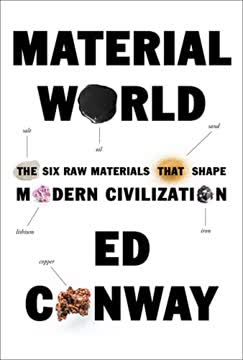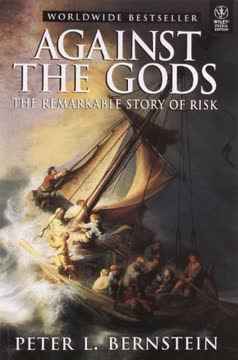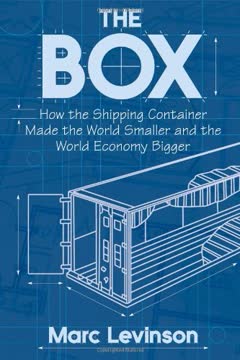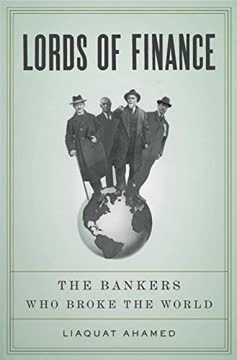Key Takeaways
1. Trade is an Intrinsic Human Drive, Shaping Civilizations
Adam Smith wrote that man has an intrinsic "propensity to truck, barter, and exchange one thing for another," and that this happy tendency was nothing more than human nature "of which no further account can be given."
Primal Urge. The desire to trade is as fundamental to human nature as the need for food, shelter, and companionship. This innate drive, observed even in prehistoric times with the exchange of obsidian and stone tools, has propelled the development of complex societies and global economies.
- Obsidian trade routes from 12,000 years ago demonstrate early long-distance commerce.
- Systematic exchanges of goods and services are unique to humans.
- Trade has driven technological innovation and cultural exchange.
Beyond Survival. Trade is not merely about meeting basic needs; it's also about acquiring status, luxury, and novelty. The desire for exotic goods, like Chinese silk in ancient Rome, has fueled long-distance commerce and shaped cultural preferences.
- The allure of silk drove trade between China and Rome.
- Luxury items from distant lands were imbued with mystery and status.
- Trade has always been about more than just survival.
Trade and Progress. The exchange of goods and services has been a catalyst for human progress, allowing societies to specialize in what they do best and to access resources and knowledge from around the world.
- Trade has facilitated the spread of technology and ideas.
- It has enabled nations to focus on their comparative advantages.
- It has directly propelled global prosperity.
2. Geography Dictates Trade Routes and Power Dynamics
The circumstances could not have been more ordinary: a September morning in a hotel lobby in central Berlin. While the desk clerk and I politely exchanged greetings in each other's fractured English and German, I casually plucked an apple from the bowl on the counter and slipped it into my backpack. When hunger overtook me a few hours later, I decided on a quick snack in the Tiergarten. The sights and sounds of this great urban park nearly made me miss the tiny label that proclaimed my complimentary lunch a "Product of New Zealand."
Natural Barriers. The physical landscape has always shaped trade routes. Mountain ranges, deserts, and oceans have created both barriers and opportunities for commerce, dictating the paths that goods and people have taken.
- The convoluted coastline of Greece made sea trade essential.
- The flat, alluvial land of Mesopotamia lacked strategic materials, necessitating trade.
- The Arabian desert's harsh climate made the camel essential for long-distance transport.
Strategic Locations. Certain geographic locations, such as straits and river mouths, have become critical choke points, controlling the flow of trade and conferring power on those who control them.
- The Hellespont and Bosphorus were vital for Athenian grain supplies.
- The Strait of Malacca controlled trade to all points west.
- Bab el Mandeb and the Strait of Hormuz are critical for oil transport today.
Climate and Resources. Climate and natural resources have also played a crucial role in shaping trade patterns, with regions specializing in the production of goods that their environment best supports.
- The monsoons dictated the rhythm of trade in the Indian Ocean.
- The Malabar Coast's rainfall made it ideal for growing pepper.
- The volcanic soil of Sicily made it a major grain producer.
3. The Camel's Domestication Revolutionized Land Trade
If man's innate desire to challenge nature at sea paid handsome dividends, his decision to do so on land, by rescuing the slow, large, and defenseless camel from the brink of oblivion, reaped similar rewards.
Desert Power. The domestication of the camel around 1500 BC transformed long-distance land trade, enabling the transport of goods across previously impassable deserts and steppes.
- Camels can carry hundreds of pounds of cargo across harsh terrain.
- They can survive for long periods without water.
- They made the trans-Asian silk and trans-Arabian incense routes possible.
Evolutionary Advantage. The camel's unique ability to store water and regulate its body temperature made it ideally suited for desert environments, allowing it to thrive where other pack animals could not.
- Camels do not store water in their humps, but distribute it throughout their bodies.
- They can passively raise their body temperature to conserve water.
- Dromedaries are better suited to hot deserts, while Bactrians thrive in cooler climates.
Crossbreeding. The crossbreeding of dromedaries and Bactrian camels produced a "super camel" that was particularly well-suited for the long distances of the central Asian overland trade.
- First-generation hybrids are stronger and more resilient.
- They can carry up to half a ton of cargo.
- They became essential for the Silk Road.
4. Islam's Rise Unified and Expanded Global Commerce
Islam provided the glue that held together an advanced system of great commercial ports, where tangles of local and mercantile families and castes from far and wide mingled together with one purpose: profit.
Religion of Trade. Islam, founded by a trader, provided a unifying force for long-distance commerce, creating a vast network of interconnected ports and trade routes from Andalusia to the Philippines.
- The Prophet Muhammad was a trader, and the Koran encourages commerce.
- Islam provided a common legal and ethical framework for trade.
- It fostered a culture of trust and cooperation among merchants.
Indian Ocean Dominance. Muslim traders dominated the Indian Ocean trade for centuries, spreading their religion and culture along with their goods.
- They controlled the major trade routes from Africa to China.
- They established trade diasporas in ports throughout Asia and Africa.
- They excluded Europeans from the Indian Ocean for nearly a millennium.
Cultural and Intellectual Exchange. The spread of Islam also facilitated the exchange of knowledge and ideas, with Muslim scholars making significant contributions to mathematics, astronomy, and medicine.
- "Arabic" numerals, algebra, and double-entry bookkeeping spread through trade.
- The need for long-range navigation spurred the development of accurate timekeeping.
- The desire to transport perishable foodstuffs led to the invention of refrigeration.
5. Control of Choke Points Defines Maritime Power
Whoever is lord of Malacca has his hand on the throat of Venice.
Strategic Waterways. Control of strategic maritime choke points has been a key factor in determining naval power and commercial dominance throughout history.
- Athens's control of the Hellespont and Bosphorus was vital for its grain supply.
- Venice's control of the Adriatic Sea made it a major trading power.
- The English and Dutch fought for control of the English Channel and the Strait of Malacca.
Modern Choke Points. Today, the world's increasing dependence on oil has made the Strait of Hormuz, Bab el Mandeb, and the Suez Canal critical strategic locations.
- A disruption of these routes would have a devastating impact on the global economy.
- The control of these choke points is a major factor in international relations.
- The U.S. Navy maintains a strong presence in these areas.
Open Geography. The open geography of the Indian Ocean, while facilitating trade, also left Muslim trading powers vulnerable to European naval dominance.
- The lack of natural choke points made it difficult to defend trade routes.
- Muslim powers did not develop a strong naval tradition.
- This left them unprepared for the European onslaught.
6. The Spice Trade Fueled Exploration and Conflict
To think that its only pleasing quality is its pungency and that we go all the way to India to get this! Both pepper and ginger grow wild in their own countries, and nevertheless they are bought by weight like gold or silver.
Luxury Goods. Spices, particularly pepper, cinnamon, nutmeg, mace, and cloves, were the premier luxury products of the medieval world, driving long-distance trade and exploration.
- They were used for flavoring food, medicine, and perfumes.
- Their rarity and exotic origins made them highly desirable.
- They were worth their weight in gold.
The Spice Islands. The Spice Islands, located in the Moluccas of eastern Indonesia, were the source of nutmeg, mace, and cloves, and their location remained a mystery to Europeans for centuries.
- The islands were small and remote, making them difficult to control.
- Their unique climate and soil made them the only source of these spices.
- The desire to control the spice trade fueled European exploration and colonization.
Venetian Monopoly. Venice controlled the spice trade for centuries, acquiring spices from the Middle East and selling them throughout Europe.
- Venetian galleys transported spices from Alexandria to Italy.
- The spice trade was the most direct route to great riches.
- Venice's wealth and power were built on the spice trade.
7. The Black Death Reshaped Global Trade and Power
The loss of lives, bottoms, and cargoes was so routine that such tragedies were usually recorded, if at all, with the short notation: "Lost with all hands."
Disease and Trade. The Black Death, caused by the bacterium Yersinia pestis, spread along trade routes, devastating populations and reshaping the course of history.
- The plague originated in Asia and spread to Europe via the Silk Road and maritime routes.
- It killed millions and disrupted trade networks.
- It weakened the Byzantine Empire and contributed to the rise of Islam.
The Mamluk Slave Trade. The Mamluk slave system, which supplied soldiers to Muslim armies, was a major factor in the spread of the plague.
- Mamluks were often purchased from areas where the plague was endemic.
- The slave trade facilitated the transmission of the disease.
- The plague weakened the Mamluk Empire.
Long-Term Effects. The Black Death had a profound impact on European society, leading to labor shortages, social upheaval, and a shift in power dynamics.
- It weakened the feudal system and empowered peasants.
- It contributed to the rise of the Renaissance.
- It created a vacuum that would be filled by a resurgent West.
8. The Columbian Exchange Transformed Agriculture and Economies
Such was the world's limited range of farm produce before the "Columbian exchange," the invasion of billions of acres of cropland by species from remote continents in the decades following 1492.
New World Crops. The Columbian Exchange, which followed Columbus's voyages, led to the transfer of crops and animals between the Old World and the New World, transforming agriculture and economies.
- New World crops like potatoes and corn became staples in Europe.
- Old World crops like wheat and coffee were introduced to the Americas.
- The exchange of crops led to a dramatic increase in agricultural productivity.
The Pig's Impact. The pig, introduced to the New World by the Spanish, had a particularly significant impact, multiplying rapidly and providing a readily available source of protein.
- Pigs thrived in the New World's tropical environment.
- They became a "commissariat on the hoof" for Spanish conquistadors.
- They contributed to the destruction of native ecosystems.
Disease and Conquest. The exchange of diseases between the Old World and the New World had a devastating impact on native populations, who lacked immunity to European pathogens.
- Smallpox and measles decimated native populations.
- Disease often preceded the physical presence of Europeans.
- It contributed to the conquest of the Americas.
9. Corporations and Free Trade: A Double-Edged Sword
The great national trading organizations, particularly the English and Dutch East India companies, spearheaded Europe's commercial dominance and made world trade the nearly exclusive province of large corporate entities and, in the twentieth century, of the multinational corporation.
Rise of the Corporations. The English and Dutch East India Companies were among the first multinational corporations, wielding immense economic and political power.
- They controlled vast trading networks and amassed huge fortunes.
- They often acted as sovereign powers, waging wars and making treaties.
- They laid the groundwork for modern multinational corporations.
Free Trade and Inequality. The expansion of free trade has led to increased global prosperity, but it has also exacerbated income inequality and created winners and losers.
- Free trade improves the overall welfare of mankind.
- It also increases disparities of wealth.
- It can lead to social unrest and political instability.
Modern Challenges. Today's globalized economy is characterized by large multinational corporations, complex supply chains, and an increasing dependence on technology and fossil fuels.
- The Internet has revolutionized communication and commerce.
- The world has become increasingly dependent on unstable sources of energy.
- The history of trade offers lessons for navigating these challenges.
10. The Struggle for Control of the Global Economy Continues
Modern life flows on an ever-rising river of trade; if we wish to understand its currents and course, we must travel up its headwaters to commercial centers with names like Dilmun and Cambay, where its origins can be sought, and its future imagined.
Ancient Roots. The origins of world trade can be traced back to ancient civilizations, with early trade routes connecting Mesopotamia, Egypt, and the Indus Valley.
- The earliest trade involved high-value goods like silk, spices, and precious metals.
- Trade routes were often long, dangerous, and expensive.
- The desire for profit drove merchants to overcome these obstacles.
The Rise of the West. The Portuguese rounding of the Cape of Good Hope in the fifteenth century marked the beginning of Western commercial dominance, which was further solidified by the rise of the English and Dutch East India Companies.
- Europeans took control of global trade routes.
- They established colonies and trading posts throughout the world.
- They transformed the global economy.
The Future of Trade. Today, the world is more interconnected than ever before, with trade playing a vital role in the global economy.
- The future of trade will be shaped by technological innovation, political stability, and environmental concerns.
- The history of trade offers valuable lessons for navigating the challenges of the twenty-first century.
- Understanding the past is essential for shaping a more equitable and prosperous future.
Last updated:
FAQ
What's A Splendid Exchange about?
- Focus on Trade's Impact: A Splendid Exchange by William J. Bernstein examines how trade has shaped human history, economies, and cultures from ancient times to the present.
- Historical Context: The book provides a chronological narrative of significant trade events, such as the Silk Road and the spice trade, and their influence on global interactions.
- Cultural Exchange: Bernstein highlights the cultural exchanges that occurred alongside trade, illustrating the economic and cultural significance of goods like silk and spices.
Why should I read A Splendid Exchange?
- Insightful Historical Analysis: Bernstein offers a comprehensive look at the history of trade, making it relevant for understanding modern economic systems and globalization.
- Engaging Narrative Style: The book combines storytelling with historical facts, making it accessible to both casual readers and history enthusiasts.
- Broader Perspective on Economics: Readers gain insights into how trade influences economies, politics, culture, and social structures across civilizations.
What are the key takeaways of A Splendid Exchange?
- Trade as a Human Impulse: Bernstein argues that trade is an intrinsic human behavior essential for survival and prosperity.
- Impact of Trade on Societies: The book illustrates how trade has led to the rise and fall of empires and shaped national identities and cultural exchanges.
- Lessons from History: Bernstein draws lessons from historical trade practices to inform current discussions on globalization and economic policies.
What are the best quotes from A Splendid Exchange and what do they mean?
- "Stable countries are trading countries.": This suggests that economic stability and prosperity are linked to a nation's ability to engage in trade, fostering peace and cooperation.
- "Globalization... is a process that has been slowly evolving for a very, very long time.": Bernstein emphasizes that globalization is a continuation of historical trade practices, encouraging a historical perspective on current global issues.
- "Trade is the lifeblood of civilization.": This quote underscores the central theme that trade is essential for the growth and development of societies.
How does A Splendid Exchange address the evolution of trade routes?
- Chronological Development: The book traces the evolution of trade routes from ancient times, such as the Silk Road, to modern global trade networks.
- Technological Innovations: Bernstein discusses how advancements in transportation and navigation technology, like the magnetic compass, transformed trade routes.
- Cultural and Economic Interactions: Trade routes facilitated not only the exchange of goods but also cultural interactions and exchanges of ideas.
What role did the spice trade play in shaping global commerce according to A Splendid Exchange?
- High Demand for Spices: Spices were highly sought after in medieval Europe, driving exploration and trade and fueling competition among European powers.
- Cultural Significance: The spice trade influenced culinary practices and social status, with spices becoming symbols of wealth and luxury.
- Impact on Exploration: The quest for spices led to significant explorations, such as Vasco da Gama's voyage to India, opening new trade routes.
How does A Splendid Exchange connect trade to the rise and fall of empires?
- Empires and Trade Networks: Empires often rose through the establishment of trade networks that enhanced their economic power.
- Decline through Economic Disruption: Empires could decline when trade routes were disrupted or when they failed to adapt to changing economic conditions.
- Lessons for Modern Empires: Bernstein draws parallels between historical empires and modern nations, emphasizing the importance of understanding trade dynamics.
How did trade influence the Age of Exploration in A Splendid Exchange?
- Spices as Motivation: The quest for spices was a primary motivation for European exploration, leading to the establishment of new trade routes.
- Cultural Encounters: Trade facilitated encounters between different cultures, resulting in significant cultural shifts and the blending of traditions.
- Economic Expansion: The expansion of trade networks contributed to the economic growth of European nations, fueling further exploration and colonization.
How does A Splendid Exchange address the concept of globalization?
- Historical Context of Globalization: Bernstein argues that globalization is a long-standing process rooted in trade history, emphasizing interconnected economies.
- Trade as a Driver of Globalization: Trade has been a primary driver of globalization, facilitating the exchange of goods, ideas, and cultures.
- Challenges of Modern Globalization: Bernstein addresses challenges like economic disparities and cultural conflicts, encouraging historical lessons for navigating global issues.
How does A Splendid Exchange explain the relationship between trade and disease?
- Trade as a Vector for Disease: Trade routes facilitated the spread of diseases, such as the Black Death, across continents.
- Historical Examples: The book provides examples like the spread of the plague from Asia to Europe via trade routes.
- Lessons for Modern Society: Understanding the historical relationship between trade and disease can inform current public health strategies.
What lessons about globalization can be drawn from A Splendid Exchange?
- Interconnected Economies: Trade has historically interconnected economies and cultures, leading to globalization.
- Impact of Trade Policies: Historical examples highlight the impact of trade policies on economic growth and development.
- Cultural Sensitivity: The book underscores the importance of cultural sensitivity in trade relations to foster better international relations.
How does A Splendid Exchange address the ethical implications of trade?
- Historical Context of Exploitation: Bernstein discusses the ethical implications of trade practices, particularly regarding exploitation and colonialism.
- Modern Parallels: The ethical considerations resonate with contemporary discussions about fair trade and corporate responsibility.
- Call for Awareness: Bernstein advocates for greater awareness of the consequences of trade practices, urging consideration of the broader impact of consumption choices.
Review Summary
A Splendid Exchange is a comprehensive history of world trade, covering its impact from ancient times to the present. Readers praise Bernstein's ability to condense vast information into an engaging narrative, though some find certain sections overly detailed or biased. The book explores how trade shaped civilizations, sparked conflicts, and drove technological advancements. While it advocates for free trade, it acknowledges its drawbacks. Many reviewers found the book enlightening and thought-provoking, despite its occasional density and complexity.
Similar Books










Download PDF
Download EPUB
.epub digital book format is ideal for reading ebooks on phones, tablets, and e-readers.






